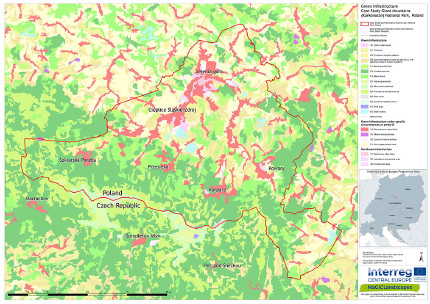Karkonosze National Park and surrounding area, Poland
The Karkonosze National Park in south eastern Poland covers the northern slopes of the Karkonosze Mountains, the largest range of the Sudetes, a mountain system shared by the Czech Republic and Poland with its highest peak Śnieżka (1,603 m). It belongs among the most valuable landscapes and natural regions in Central Europe. The area is known for its high biodiversity in four altitudinal vegetation belts, from sub-montane to alpine. The mountains constitute a kind of ecological island of arctic and alpine ecosystems whose counterparts are found in the Alps and north and north-west Scandinavia. In Karkonosze National Park the highest mountain belts: sub-alpine and alpine are especially valuable and are under strict protection.

Karkonosze National Park and surroundings
Some of the most interesting areas include: the highest peat bogs in Europe (designated under the Ramsar Convention), post-glacial cirques, block fields, ponds, granite rocks and dwarf pine shrubs. The area is especially important for biodiversity with many endemic and relic species of fauna such as Campanula bohemica, Saxifraga moschata ssb. basaltica, Pado sorbetum, Saliceti lapponum, Pendicularis sudetica, Saxifraga nivalis.
The Karkonosze region has a very rich history of human activity the remnants of which can be found across the area including medieval castles, chapels and charming mountain hostels. There are also some relics of industrial development in the past such as loom houses and glass-works.
Today the Karkonosze Mountains are a popular tourist destination for hikers and skiers with around 2 million visitors per year just on the Polish side. The high number of mountain hostels and tourist trails mainly situated within the strict protection zone contributes to the increasing tourist pressure, one of the biggest threats for the Park’s nature and landscapes.
On both sides of the border there are National Parks: in Poland Karkonosze NP cat. II of IUCN was established in 1959 and in the Czech Republic the Krkonoše National Park (IUCN Category V) was established in 1963. They have a combined area of around 425 km2.
In 1993 and in order to provide a forum of communication between the decision-makers of the cross-border region, local stakeholders and experts, both National Parks were officially recognized by UNESCO as the Bilateral Biosphere Reserve Krkonoše/Karkonosze, the Park area and its buffer zone are also designated as Natura 2000 sites (Bird and Habitats).
Download flyer of case study area Karkonosze National Park and surroundings (in Polish)
Regional Workshops in the Karkonosze National Park and surroundings (in Polish)
Regional green infrastructure maps of the Karkonosze National Park and Jelenia Góra Basin
Green infrastructure functionality maps of the Karkonosze National Park and Jelenia Góra Basin
Green Infrastructure Strategy & Action Plan Karkonosze National Park and Jelenia Góra Basin
If you are interested in the pdf version of all maps of green infrastructure which are linked above feel free to contact Dorota Wojnarowicz from the Karkonosze National Park Administation in Jelenia Góra/Poland.
Header photo: M. Wojnarowicz
Back to CASE STUDY AREAS or MAIN PAGE
